#American School of Classical Studies in Athens
Photo

John Wesley Gilbert
Born into slavery in rural Georgia, John Wesley Gilbert (1863-1923) rose to national prominence as a scholar, teacher, community leader, and Christian missionary. During 1890-91, he was the first African American member of the American School of Classical Studies at Athens. He was among the first 50 Americans of any race, ethnicity, or background to conduct professional archaeological work in Greece.
For much of the 20th century, Gilbert was best known for his 1911-1912 mission to the Belgian Congo with white bishop Walter Russell Lambuth of the Methodist Episcopal Church, South or MECS (the MECS has since become part of the United Methodist Church). Gilbert's 1890-1891 sojourn in Greece at the American School of Classical Studies at Athens, in contrast, often received passing word but never serious study. In 2011, the newly founded Society of Black Archaeologists recognized Gilbert as the first professionally trained African American archaeologist. Today, he is often called "the first black archaeologist." Yet his life, and especially his year in Greece, has never received the in-depth exploration it deserves, until now.
Lost Records
No one was sure how the fire started. In the pre-dawn hours of 3 August 1968, flames swept through Haygood Memorial Hall, the main building of historically black Paine College in Augusta, Georgia. Bystanders gathered to watch helplessly as the blaze climbed up, engulfing Haygood's famous clock tower, which for nearly 70 years had rung out the hours loud enough to be heard across town. The structure was still smoldering at sunrise. The clock tower stood but was too damaged to save and had to be pulled down. Inside was devastation. Though fireproof cabinets protected recent student records, the offices of Paine's president and vice president were destroyed, along with a priceless collection of African artifacts. Many of the school's early catalogues, newspapers, and other records also perished.
Author Promotion
Continue reading...
30 notes
·
View notes
Note
Hi! I was reading your pinned post and realized that you were a professor at PSU! I’m currently an archaeology/ancient mediterranean studies student here, so that’s pretty cool. Anyways, I was just wondering if you knew about any on going research projects going on regarding Alexander the Great (or anything related). May it be digs, archival work, research- I’m super interested in this area of history and wanna get involved!! Sorry if this is a long shot but I wanted to ask. Thanks!
Hello, there, fellow Nittany Lion!*
Yes, I got my PhD from Penn State and taught there for Religious Studies and Classics both as a lecturer back in the late 1990s.
As for digs, there is one at Pella, but it's already filled out for this season. But keep an eye on it; I believe next season may be the last? I've got a former student who'll be there this year (and perhaps next).
Dig at Pella via AIA
Pella Urban Dynamics Project (U. Mich)
Keep an eye on the AIA (Archaeological Institute of America) site for other opportunities in Greece.
Also, message me if you would, so I have your actual name and email, and I'll keep you in mind if I hear of other opportunities. Let me know who you're studying with at PSU (Mark Munn?). Dr. Munn has digs of his own, and TBH, when it comes to experience with archaeology, any dig will give you some experience.
You should also look into summer programs offered through the American School of Classical Studies at Athens. They've had Macedonia-centric programs in the past. One, in fact, got tanked by Covid. So bookmark that site and, in fact, explore it thoroughly, if you're not already well familiar with the ASCSA.
(Spelling out some of these acronyms for those unlikely to recognize them.)
--------
* For the unintiated wondering what the heck a "Nittany" Lion is ... it's a (mountain) lion that lives on Mt. Nittany, of course. *snort* Penn State (located in State College, PA) nestles in "Happy Valley" which lies between (low) mountain ranges, and one of these is "Mount Nittany." It's actually an extremely lovely place, but also one of the few I had SERIOUS allergy problems for my entire 8 years there. Pollen counts are crazy.
#American School of Classical Studies in Athens#Pella Urban Dynamics Project (U. Mich)#Pella Greece#ancient Macedonia#ancient Pella#Alexander the Great#archaeology in Greece#archaeology in Northern Greece#Penn State#asks
5 notes
·
View notes
Text

4 notes
·
View notes
Text
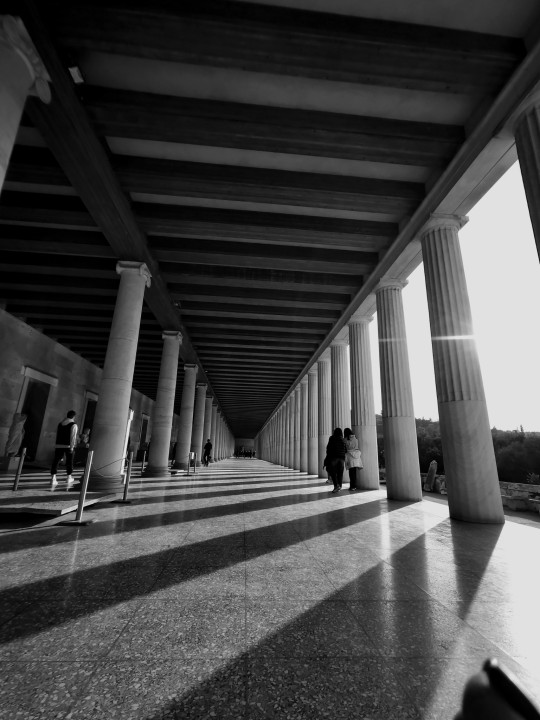
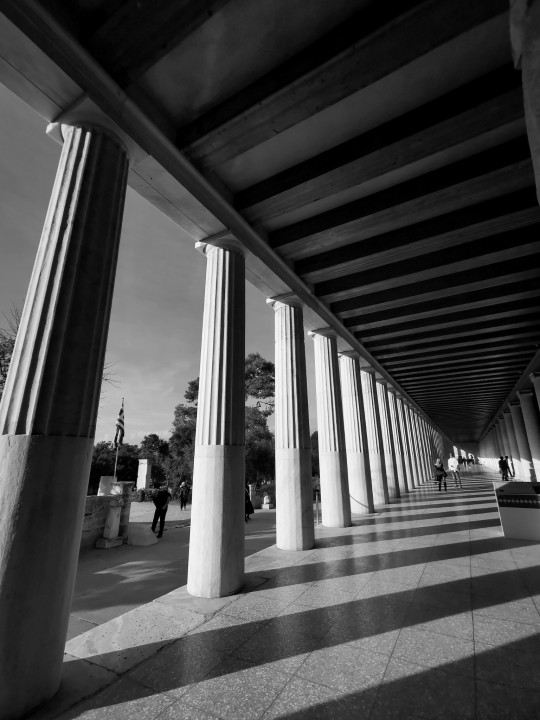
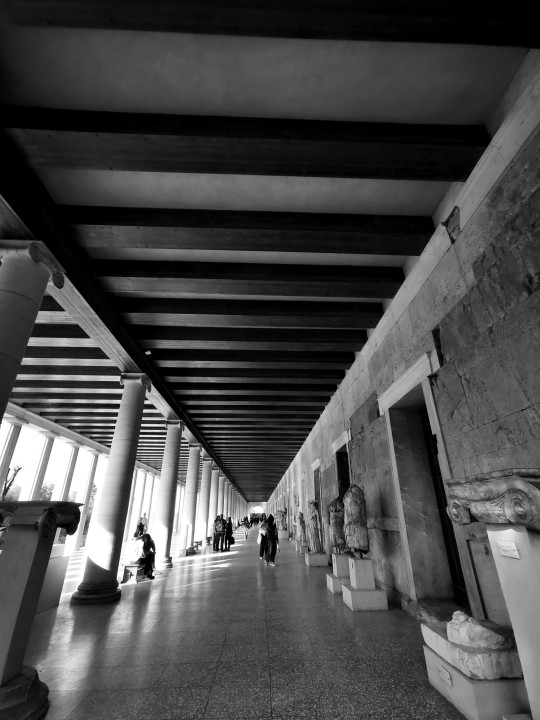

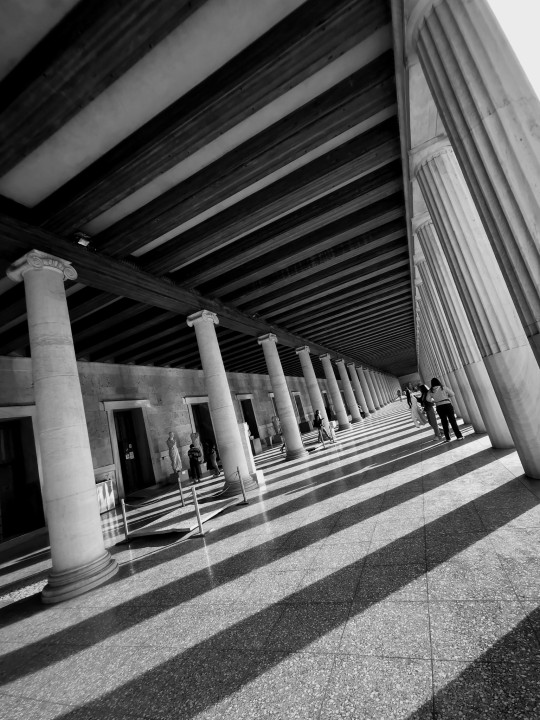

The Stoa of Attalos was a stoa (covered walkway or portico) in the Agora of Athens, Greece.It was built by and named after King Attalos II of Pergamon, who ruled between 159 BC and 138 BC. The current building was reconstructed from 1952 to 1956 by the American School of Classical Studies at Athens and currently houses the Museum of the Ancient Agora.
39 notes
·
View notes
Text
you got your known Minoans and your unknown Minoans (part two)
(reposted, with edits, from Twitter)
(part one on Tumblr)
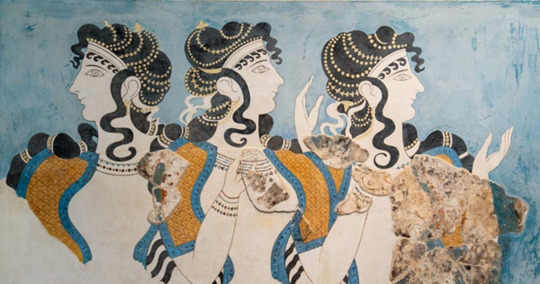
So, in Part One of this, I talked about the “Minoan” Boston Goddess statue and how she’s probably a forgery, and a little bit about how explicit Victorian archaeologists were that they wanted Minoan civilization to be a European civilization that was just as old and sophisticated as civilizations from Asia and the Near East.
Anyway, the Boston Goddess, Greek Gibson girl, delicate but dapper pre-Danaan dame...
She has no provenience. (I learned a thing: provenance is art, provenience is archaeology.) That is, she is without archaeological context. We don't know where she was found.
All those ecstatic articles about her are pretty cagey about where she actually came from. Caskey carefully says, allowing passive voice to do a lot of work, "according to information believed to be reliable, it came from Crete," and everyone else seems to have just run with that.
His successor as curator, Cornelius C. Vermuele III, who sounds like a walking Stiff Upper Lip, claims that the statue arrived via "a Greek-speaking Boston lady returning from the American School of Classical Studies in Athens," (natch, because she wouldn't have been the sort of lady to just vacation there).
Anyway, this Greek-speaking but safely Bostonian lady happened to befriend some Cretan immigrants in steerage--so enlightened--and they showed her the Boston Goddess--in fragments at the time--in a tin and she was like, HUP HUP MY DEAR SWARTHY FOLK YOU MUST TAKE THIS TO THE MFA.
And of course that was how it found its way into its proper home in a Boston museum--which of course purchased it for a "fair price"--and not with Greeks traveling in steerage.
No one at the museum could name this beneficient Boston lady who guided the figurine there, of course.
So then, another museum employee, Cyrus Aston Rollins Sanborn, who sounds like a walking handlebar moustache, tells the same story except now it's a male archaeologist befriending a lone Greek man in steerage. Everyone agrees on the "steerage" part, though, so that's something. Her fragments were maybe in a cigar box, maybe in a cigarette tin (the museum still has some fragments too small to be used in the restoration in a comely soap box), but I digress.
There weren't any ships sailing from Piraeus to Boston during the specified period, but it would be low-brow of us to concern ourself with things like facts about where one of the most important archaeological discoveries about the CRADLE OF EUROPEAN CIVILIZATION came from.
Anyway, I promised you I'd bag on Arthur Evans so let's do that:
Arthur Evans went to Crete looking or evidence of prehistoric European writing systems because he couldn't stand the fact that Middle Easterners invented our alphabet. (No, I mean, Mysteries of the Snake Goddess literally says: “he was hoping to prove early Europeans were no less literate than ancient Egyptians and Mesopotamians.”)
Speaking of Crete, it was having a bit of a day back around the turn of the last century.
Until 1898, the Ottoman Empire ruled it
Until 1913, it was a protectorate of the Great Powers
After 1913, it was part of the Hellenic Republic of Greece
But they all agreed on one thing: STOP LOOTING THE PLACE AND CARTING OFF ALL ITS STUFF.
So unless something was a "duplicate" or insignificant, you had to turn it over to the authorities. But Arthur Evans was a Britisher, by golly, and wasn't going to be told what he could and couldn't do while hunting proof that Europe had always been just as sophisticated as Africa, Asia, and the Middle East.
He'd already robbed tombs at Trier, skulls from Dubrovnik, and antiquities from Psychro, Trapeza, and Karphi. He knew that the archaeological importance of objects is deeply linked to their context, but considered rules about unauthorized digging "frivolous.” And he felt bad for collectors, rich people being stymied by all those rules--so, well, those rules would just have to be broken, even if that resulted in a "permanent injury to science."
In 1908, a Cretan customs agent caught him smuggling stuff he'd looted out of Crete. Rather than give it back, he tossed the package into the harbor.
He also got the customs agent fired.
In Part Three: this fine upstanding gentleman excavates the palace at Knossos, misplaced cats, fantasy worldbuilding, and Isadora Duncan being insufferable.
#archaeology#minoans#arthur evans#crete#white supremacist archaeology#snake goddess#art forgery#sketchy museum curators#mysterious greeks bearing gifts#mysterious bostonians bearing grifts#minoan
34 notes
·
View notes
Note
Because the West has it's society foundation based on Ancient Greece, they think they are familiar with it and think they can make changes for anything related to it.
The reason they don't do it to other countries' mythologies is because it's something foreigner to them like Indian, Asian mythology. They view it as something new, they will study it, but will never feel like they know it.
That's why so many USians and Europeans still make projects, movies, series, books still about Greek mythology, because they are more used to it.
Yup, that's the deeper reason I detect as well. I would also argue they don't exactly based their societies on ancient Greece. I mean, 1800 yrs ago of course they took some important elements and I don't deny it was transformative to some degree at the time and its echoes exist even today. But I feel as if the amount of ownership they feel over our heritage is borderline (negative) nationalistic. They are not familiar with the whole of ancient Greece, they actually only know by default something like 1% of it, which one would expect to be much more if their countries were based on that heritage.
They just point out a few ancient systems and boom! "Ancient Greece belongs to all of us". Franz, dear, you can't even suspect what these people ate for breakfast. Chill. Besides, there's a very good chance your medieval compatriots had no idea about these things until Greek war immigrants came to your land with the ancient texts they preserved.
Next thing imma say "Britain belongs to us" because at the moment our political system is parliamentary democracy (A quite removed democracy system from the one of ancient Athens), because Shakespeare had a huge impact on our theatre, because their poets and philosophers have radically influenced many of our important figures. Or I could say "the US belongs to the Greeks", because we are slowly Americanized in all aspects of our lives. Oh, it doesn't go like that? Oh, we need more than basic systems and a few trends to claim a culture?? How interesting!
And notice how they never say "based on" things about Middle Easterners, who did CRAZY good progress on astronomy, poetry, literature, physics, mathematics (they defined the form of the numbers we use today, like 1,2,3...!!), philosophy (they expanded Aristotle's and Plato's philosophy and became the next very famous school of thought), fucking ALGORITHMS and medicine (they freaking discovered that the heart pumps blood to the body which is hella important in my humble opinion 😂) Sure, sometimes Europe and the Middle East-Balkans were isolated but you cannot tell me Westerners took NOTHING of these basic inventions that define our world today. The site we converse on is based on an Algorithm. But there they can afford to make the distinction between "I take elements" and "I base my culture on theirs".
>> Obviously #notallwesterners and if one is a Classics student we are not gonna hang them from the sycamore (πλατάνι) of our village, or directly assume they are disrespectful. These discussions and rants take place so biases are detected and the field becomes better.
27 notes
·
View notes
Text
John Wesley Gilbert: The First Black Archeologist
Was born in 1863 in Georgia. After he and his mother were freed from slavery he attended a segregated school where he was taught by the famous educator Lucy Craft Laney.
He worked at a teacher assistant for some years before going to a Baptist sponsored school called the Augusta Institute.
When the school became the Atlanta Baptist Seminary he went with them until he had to return to Augusta due to fiances where he returned to teaching.
He eventually enrolled as the first student in Augusta's Paine Institute where his mentor taught him Greek and helped to win admission to Brown University.
John W Gilbert was Brown's third Black graduate. In 1888 in unprecedented move Gilbert was hired as the first Black professor to teach at Paine Institute where he taught, including Greek, 5 languages.
He was then one of 50 students and the only Black students in American School of Classics Studies at Athens.
During the year he spent in Greece he participated in an excavation of Eretria, wrote a thesis on the demes of Athens, studied the excavated supposed tomb of Aristotle. He also did a survey on the topography Eretria that is incredibly valuable and is used till this day.
His work saw Brown awarding the A.M degree to him, the first time a degree of such type went to a Black person at Brown.
He was very active in the civil rights movement, in interracial cooperation, and the advancement of Black economics.
In his missionary work in Belgian occupied Congo he translated parts of New Testament from the Christian bible into Otetela.
He died in 1923 and is buried Augusta, Georgia.
He and his wife, Osceola Pleasant (1862-1922), had four children.
Source
10 notes
·
View notes
Note
hello where did you find the levitis l'illiade oratorio? it sounds super interesting but i haven't been able to find it anywhere
thank you!
hi! the gennadius library at the american school of classical studies in athens has a digitized manuscript of the conductor's score (which is how i found out about it: check the dimitry levidis papers collection) but i am also unable to find a published/edited version or a recording :( i'm also bad at both greek AND french AND sight reading scores so trying to figure out what this sounds like is currently a very interesting struggle lmao
2 notes
·
View notes
Text
ANNIE SMITH PECK // MOUNTAINEER
“She was an American mountaineer and adventurer. Passionate suffragist and renowned lecturer. She wanted to attend Brown University, Rhode Island, like her father and brothers but was refused admission because of her gender. She finally got a place at the University of Michigan. In 1886 she was the first woman to attend the American School of Classical Studies at Athens. She began mountaineering about the same time, and was criticized for wearing trousers while climbing. The northern peak of the Peruvian Cordillera Blanca mountain chain, Huascarán, was named Cumbre Aña Peck in her honour. In 1911, aged sixty-one, Peck climbed one of the five peaks on Coropuna in Peru and placed a 'Votes for Women' banner at the summit.”


0 notes
Text

Rev. Dr. John Wesley Gilbert (July 6, 1863 - November 18, 1923) was an educator, a missionary, and the first African American archaeologist. He was the first graduate of Paine College, and the first African American to receive a MA from Brown University.
He was born in Hephzibah, Georgia to Gabriel and Sarah, farmhands born enslaved. He attended the local public schools while working as a farmhand. He first enrolled in Augusta Institute in 1878 and remained there for two years, before he began teaching at Ware High School. He enrolled at Paine College, becoming the institution’s first student. He attended (1884-86) and studied Greek and other foreign languages. He transferred to Brown University. He was one of the first ten African American students at the university and the third African American to receive his AB.
He married Osceola K. Pleasant, a tear, and a graduate of Paine College and Fisk University, they had four children together. He received a scholarship to attend the American School of Classics in Athens. He was the first African American to attend the school and participated in archaeological fieldwork. He found walls, gates, and pillars that led to the discovery of the ancient Greek city of Eretria. He created the first map of the area. He focused his studies on archaeology and became the first African American to receive an advanced degree from the institution, earning his MS in Archaeology.
He returned to Augusta and began teaching Greek, Latin, English, French, German, and Hebrew at Paine College. He was the first African American instructor at the school. He attended Gammon Theological Seminary received his D.Div, and became a CME minister. He was elected to the American Philological Association.
He returned to teaching at Paine, and he traveled to the Belgian Congo, to establish a Methodist presence, along with Minister Walter Russell Lambuth. They established a church and school in the village of Wembo-Nyama.
He was appointed President of Miles College. He returned to teaching Greek, Hebrew, and New Testament literature, and serving as the Dean of the Divinity School. #africanhistory365 #africanexcellence
0 notes
Text
National Arts Club to Award Medal of Honor to the American School of Classical Studies at Athens
The School will be honored for its contributions to the field of archaeology
The National Arts Club (NAC) is thrilled to award the Medal of Honor for Achievement in Archaeology to the American School of Classical Studies at Athens (ASCSA). The award ceremony will take place on Wednesday, January 24, 2024 at 6:00 pm at the landmarked Tilden Mansion, the home of the NAC, at 15 Gramercy Park South,…

View On WordPress
0 notes
Text
Cataloging Librarian for the Gennadius Library in Athens
https://themanfrommensa.com/category/shop/
CATALOGING LIBRARIAN FOR THE GENNADIUS LIBRARY IN ATHENS
(Position in Athens)
The American School of Classical Studies at Athens (ASCSA) invites applications for the position of Cataloging Librarian at the Gennadius Library in Athens. The American School of Classical Studies at Athens (ASCSA) is one of the world’s leading research and teaching…
View On WordPress
0 notes
Text
A young Black American Classicist talks about the depiction of Africans in ancient Greek pottery (and explains why Herodotus is his favorite ancient Greek)
“ Constructing the African: A Panoply Interview with Najee Olya.

We’re delighted to have the chance to speak to Najee Olya, a PhD student at the University of Virginia, USA, working on the dissertation, Constructing the African in Ancient Greek Vase-Painting: Images, Meanings and Contexts. Before beginning doctoral study, Najee earned a B.A. in Anthropology and Classical Civilization at the University of Illinois at Chicago and an M.A. in Classics at the University of Arizona. In the field, he has participated in archaeological excavations in Italy at Etruscan Populonia at Poggio del Molino, and since 2018 at Mt. Lykaion in Arcadia, Greece. Najee is currently a William Sanders Scarborough Fellow at the American School of Classical Studies in Athens, researching vases in Greek collections and their archaeological contexts. The next academic year will see him take up a post as the Bothmer Fellow in the Department of Greek and Roman Art at the Metropolitan Museum in New York. In this interview, Najee offers insight into his research on Africans in ancient Greek pottery…
1) What contexts do you think ancient Greeks and ancient Africans are encountering each other in?
I think that the primary context would be in Egypt. Given that there are Greeks in Egypt in the Archaic period as mercenaries and at Naukratis, it must be there that Greeks are encountering not only Egyptians but people from elsewhere in Africa, especially from south of Egypt itself—what the Greeks generally referred to as Aithiopia (not to be confused with the modern state). I also suspect that major hubs of maritime trade would have been the sorts of places where Greeks encountered people from Africa, at various ports and emporia – trading posts - around the Aegean and the wider Mediterranean. Conversely, I’m inclined to think that direct contacts on the Greek mainland were somewhat limited. That said, in a major city like Athens, for example, the interest in Africans among potters and vase-painters seems to indicate at least some kind of familiarity with what Africans looked like that doesn’t appear to come from just seeing artistic depictions. Moreover, there were almost certainly foreigners and people of foreign descent working in the Kerameikos in Athens, so it's impossible to rule out that at least one or two may have been from Africa. There’s also Athens’s port at Piraeus, which saw a lot of traffic from a variety of traders and merchants.
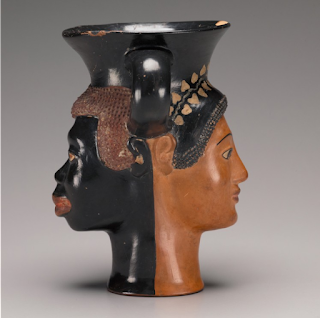
Above, a janiform cup (ie. two heads back-to-back like the god, Janus), showing an African and a European, Attic c.500-450BCE, The Art Museum, Princeton University: 33.45.
2) Who are the Africans depicted in Greek pottery – what trends are there?
There are three categories, as far as I can tell, into which the Africans depicted in Greek pottery can be grouped. Two of these are fairly straightforward mythological episodes and scenes of daily life. The third is more difficult, and consists of imagery that doesn’t fit neatly into either of the two other categories.
In terms of the mythological episodes, the main figures from Africa are Memnon and Andromeda. The pair are both said to be royalty from Aithiopia in the mythological tradition. Memnon was king of Aithiopia and an ally to Troy in the Trojan War, where he led a huge army from Aithiopia before eventually being killed by the hero Achilles. Andromeda was an Aithiopian princess who was offered up as a sacrifice to appease the ketos serpent, a sea monster sent by Poseidon to ravage the coasts of Aithiopia after Andromeda’s mother Cassieopeia had boasted that she (Cassieopeia) was more beautiful than the Nereids. Andromeda was rescued by Perseus, and the two married. In vase painting, Neither Memnon nor Andromeda are shown as African themselves, but there are instances in the iconography where Memnon is shown preparing to depart for Troy attended by African warriors.
In the Andromeda scenes, she is shown being bound between stakes for the ketos monster, sometimes in Persian dress. There are Africans on a number of the Andromeda vases. There are some mythological traditions which associate Memnon and Andromeda with the Near East, so this might explain why they are not depicted as African themselves.
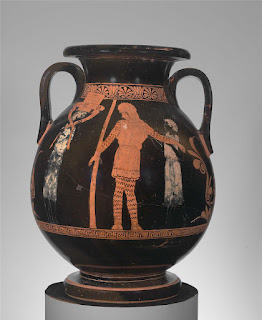
Above, Andromeda with African attendants, Attic pelike c.475-425BCE, Boston Museum of Art, 63.2663.
Next, there are depictions of the hero Herakles in Egypt and Libya. In Egypt, he encounters the pharaoh Busiris, who wants to sacrifice the hero to end a drought. On pottery Herakles is shown routing Busiris and his priests, who are always depicted as African men. In Libya, Herakles is accosted by the earth giant Antaios, who waylays strangers, forces them to wrestle, and then adorns the temple of Poseidon with their bones after he has killed them. Herakles defeats Antaios by lifting him from the ground as they wrestle and cutting him off from the Earth, from which he derived his strength. On pottery, physical contrast is shown between the two as they wrestle—Antaios has a long unkempt beard and hair, similar to Egyptian depictions of Libyans.

Above, Heracles fights Busiris, Attic pelike c.500-450BCE, Athens, National Museum: CC1175.
As for images from daily life, we have African stable-hands, warriors, and some attendants at the grave. These figures can generally be identified by their very curly hair and prominent noses. The last set of objects includes things like plastic vases, which show either full African figures or African faces alone or paired with women, satyrs, Herakles, and Dionysos. Finally, there are alabastra, a shape that rather circuitously made its way to Greece from Egypt, used for perfumed oil which depict African warriors.
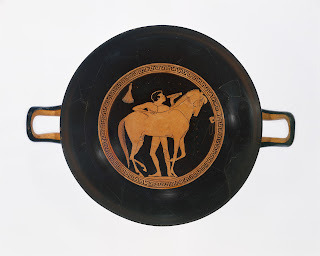
Above, An African groom cares for a horse, Attic kylix c.490, Metropolitan Museum of Art, 1989.281.71.
3) Some Africans seem to be represented rather beautifully; other depictions feel a bit… off. What’s the balance between realism, idealism, and hostile caricature in ancient Greek depictions of Africans?
On the whole, I would say that most of the depictions are not hostile caricature. I can think of one example, a lekythos in the National Archaeological Museum in Athens, which shows what seems to be an African woman being tortured by satyrs. There is also at least one image of a figure who may be African shown wearing shackles and is unambiguously an enslaved person. I do not think, however, that it is possible to definitively call either instance caricature.
Plastic vessels made in the form of African youths being attacked by crocodiles have sometime been interpreted as cruel, mocking images, but one can just as easily say that these show interest in the river Nile and awareness of its dangerous fauna. Aside from these examples, however, I think that many of the images are either ambiguous or benign. It is difficult to know what the representations were meant to convey to ancient Greek users. When it comes to realism, the images are realistic to a degree, but as with all ancient Greek art, it is superficial and illusory. Especially when it comes to pottery, I think that one has to remember that the medium and its convention limit just how true-to-life the representations can be. The end result is something of a pastiche of reality and imagination—the vase-painter selects the subject matter and then executes it in his own way, but the final product will always be constrained by things like the limited colour palette and the curving surface of the vase.


Above, an African youth attacked by a crocodile, Attic rhyton, c.350BCE, Fitzwilliam Museum, Cambridge GR.58.1865.
4) Overall, what does pottery add to our understanding of ancient Greek ideas about Africans and Africa?
First and foremost, I think it reminds us that ancient Greece was part of an interconnected ancient Mediterranean. Also, that “ancient Greece” spanned three continents, with settlements and poleis not just in Europe but also in North Africa and Western Asia. Pottery tells us that ancient Greeks were interested in depicting foreign people such as Africans, and while it is difficult to interpret all of the different representations, it is clear that potters and vase-painters found Africans an intriguing subject, and that the purchasers of Athenian vases did too. The representations, in a general way, seem to indicate that Athenians were thinking about North Africa in particular, especially Libya and Egypt, where there were permanent Greek settlements. What they specifically thought about Africans is harder to determine from the pottery itself, but it does not seem to be the case that Africans were viewed any differently than other foreigners. Certainly, there was a general chauvinism toward non-Greeks, but Africans do not appear to have been singled out more than other groups, such as Persians or Scythians.

Above, An African in trousers, Attic alabastron, c.500-450, The J. Paul Getty Museum: 71.AE.202.
5) What would you like to see improved in terms of using pottery to increase general understanding of Black people within ancient Greek culture?
One thing that could use some improvement is the terminology used to describe the artifacts, which is often simultaneously both outdated and anachronistic. In scholarship this is due in part to the rather small corpus dealing with Africans on Greek pottery, much of which is several decades old now. Also, you will often see in museums or on museum websites descriptions that assume the depictions of Africans on vases are slaves, without any explanation, or descriptions that make use of discredited race-essentialist anthropology to discuss their physical characteristics.
I think that it’s extremely important to rethink how Greek vases with depictions of Africans are presented in museums, as those are the spaces where the wider public is most likely to encounter the artifacts. Some museums are already making efforts to rethink their use of language for the objects, such as the J. Paul Getty Museum and the North Carolina Museum of Art. I was recently asked by a curator at the latter to write a new label for an Athenian black-figure vase in their collection which has a depiction of Memnon and one of his African warriors. Hopefully the number of museums revamping their descriptions will increase going forward.

Above, King Memon with African attendants, Attic amphora by Exekias, c.575-525, British Museum, B209, previously 1849,0518.10.
6) Perhaps you could tell us a bit about your Fellowships – what they are, how they work?
I’ve been fortunate enough to have been awarded several fellowships that allowed me to study in Greece — from the American School of Classical Studies at Athens (ASCSA) and the American Philosophical Society (APS). I started out at the American School in 2017 with a scholarship for the Summer Session, which is a six-week course involving travel around Greece to archaeological sites and museums. I came back to the ASCSA two years later in 2019 with a fellowship to participate in the Regular Program, which is an academic year spent in Athens, travelling around Greece more than the Summer Session. Now, I’m wrapping up my third stay at the American School with a fellowship as an Associate Member. This time, I’m focused entirely on working on my dissertation and taking the opportunity to revisit artifacts in museums relevant to my research, in addition to obtaining special permission to photograph many of the vases outside of their displays.
I received a Lewis and Clark Grant from the APS in 2019, which allowed me to do field research in Greece. I travelled to archaeological sites that are documented as having had material from Egypt excavated there, created an archive of photographs, and got a better sense of the sites and their topography from first-hand observation. Finally, in September 2022 I’ll be at the Metropolitan Museum of Art in New York for a year as the Bothmer Fellow in the Department of Greek and Roman Art. The fellowship will allow me to complete my dissertation and to access a number of the vases included in it, as well as the Met’s libraries. It’s worth keeping your eyes open to see what opportunities and funding are available.
7) Who’s your favourite ancient Greek?
It might be an obvious answer, but I will say Herodotus. I first read the Histories almost fifteen years ago as a Classics undergraduate, first in translation in a course taught wonderfully by Nanno Marinatos, and then in ancient Greek language courses. I think that it must be Herodotus’s interest in different cultures and his efforts to understand and make them legible for his readers that resonated with me, especially as someone who had already studied a bit of anthropology and archaeology before I came to Classics. As much as I enjoyed Herodotus years ago, I had pretty much left him behind until I selected my dissertation topic at the end of the first year working on the PhD. Since then, I’ve been revisiting him, as he famously writes about both Egypt and Aithiopia. I still read the Histories with a sense of wonder, but now I appreciate the complexity and sophistication of the work even more. Herodotus is one of the people from antiquity that I’d love to have a chat with if time travel were possible!
Many thanks to Najee for sharing his expertise!”
Source: http://panoplyclassicsandanimation.blogspot.com/2022/06/constructing-african-panoply-interview.html
Panoply is the blog of historian of ancient Greece Dr. Sonja Nevin and of animator Steve Simons.
1 note
·
View note
Text
Bibliography
Aristophanes. “Lysistrata.” Jack Linsey. 411 BC. https://www.gutenberg.org/cache/epub/7700/pg7700-images.html
Aristotle, The Politics of Aristotle, trans. Benjamin Jowett (London: Colonial Press, 1900), pp. 30-49.
Ayelet Gilboa, Yiftah Shalev, Gunnar Lehmann, Hans Mommsen, Brice Erickson, Eleni Nodarou, and David Ben-Shlomo. “Cretan Pottery in the Levant in the Fifth and Fourth Centuries B.C.E. and Its Historical Implications.” American Journal of Archaeology 121, no. 4 (2017): 559–93. https://doi.org/10.3764/aja.121.4.0559.
Bain, Robert E. M. The Temple of Jupiter Olympus, Athens. B&w , 25.4 x 18.1 cm ( 10 x 7.125 in). (Holborn Hall) London: W.A. Hammond, n.d. https://jstor.org/stable/community.21866467.
Bain, Robert E. M. The Temple of Jupiter Olympus, Athens. B&w , 25.4 x 18.1 cm ( 10 x 7.125 in). (Holborn Hall) London: W.A. Hammond, n.d. https://jstor.org/stable/community.21866467.
Barbara A. Barletta. “Greek Architecture.” American Journal of Archaeology 115, no. 4 (2011): 611–40. https://doi.org/10.3764/aja.115.4.0611.
Bardis, Panos D. “Artemisia II.” Science 230, no. 4723 (1985): 237–237. http://www.jstor.org/stable/1695339.
Carter, Jane Burr. “The Masks of Ortheia.” American Journal of Archaeology 91, no. 3 (1987): 355–83. https://doi.org/10.2307/505359.
Carroll, Mitchell. "Greek Women." 96-260. Philadelphia: Rittenhouse Press, 1908
Dickins, Guy. “The Art of Sparta.” The Burlington Magazine for Connoisseurs 14, no. 68 (1908): 66–64. http://www.jstor.org/stable/857666.
Dinsmoor, William B. “The Mausoleum at Halicarnassus: II. The Architectural Design.” American Journal of Archaeology 12, no. 2 (1908): 141–71. https://doi.org/10.2307/496810.
Herodotus, The History, trans. George Rawlinson (New York: Dutton & Co., 1862).
Katz, Marilyn A. 1998. “Did the Women of Ancient Athens Attend the Theater in the Eighteenth Century?” Classical Philology 93 (2): 105. doi:10.1086/449382.
Mausoleum at Halicarnassus Restored View from West. ca. 353 B.C.E. https://jstor.org/stable/community.12073223.
Palagia, Olga. “Art and Royalty in Sparta of the 3rd Century B.C.” Hesperia: The Journal of the American School of Classical Studies at Athens 75, no. 2 (2006): 205–17. http://www.jstor.org/stable/25067983.
Pausanias, Description of Greece with an English Translation by W.H.S. Jones, Litt.D. in 4 Volumes. Volume 1.Attica and Cornith, Cambridge, MA, Harvard University Press; London, William Heinemann Ltd., 1918.
“THE SEVEN WONDERS OF THE WORLD.” The Connecticut Common School Journal (1857-1866) 4 (12), no. 6 (1857): 167–69. http://www.jstor.org/stable/44750064.
Pfaff, Christopher A. “Archaic Corinthian Architecture, ca. 600 to 480 B.C.” Corinth 20 (2003): 95–140. https://doi.org/10.2307/4390719.
Powell, Benjamin. “The Temple of Apollo at Corinth.” American Journal of Archaeology 9, no. 1 (1905): 44–63. https://doi.org/10.2307/496822.
Ratté, Christopher. “Athens: Recreating the Parthenon.” The Classical World 97, no. 1 (2003): 41–55. https://doi.org/10.2307/4352824.
Thukydides, Pericles' Dictum on Women, c. 395 BCE https://sourcebooks.fordham.edu/ancient/700greekwomen.asp
0 notes
Photo







Ease into Corona quarantine mode with best practices and advice from the collections of Ancient Corinth!
Compiled by American School of Classical Studies at Athens Steinmetz Family Foundation Museum Fellow Eleni Gizas.
Source: American School of Classical Studies at Athens
#Greece#Corona virus#Archaeology#Corinth#American School of Classical Studies#Athens Steinmetz Family Foundation
589 notes
·
View notes
Photo

1898 / “The American School of Classical Studies at Athens initiated excavations in Ancient Corinth in 1896” / https://bit.ly/2Ch2JCp
#19ος αιώνας#american school#classical studies#athens#excavation#corinth#ancient corinth#άγαλμα#ανασκαφή#αμερικανική σχολή#κλασικών σπουδών#αρχαία κόρινθος#κόρινθος#ascsa
27 notes
·
View notes